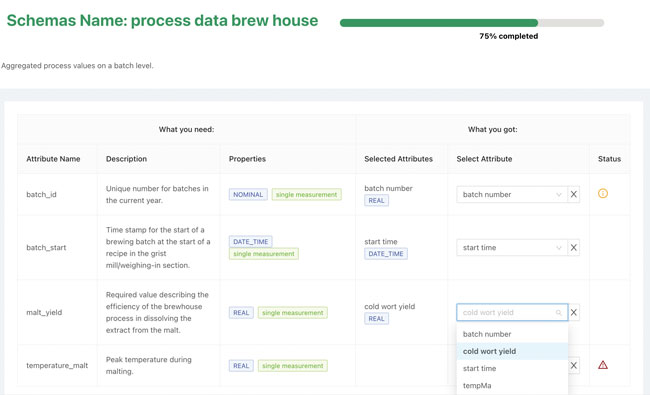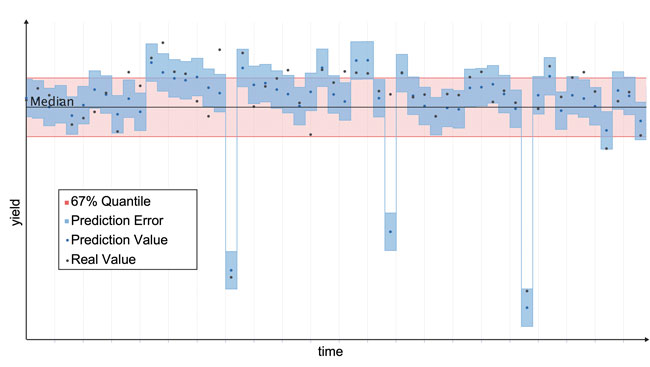Machine learning in breweries (Part 2): Straightforward introduction to AI
Toolbox | Huge, heterogeneous data files are created throughout the whole process chain of a brewery. Analysis of same opens up both opportunities and challenges. This contribution presents new tools as well as applications from the research project “Data-driven Process Optimisation using Machine Learning in the Beverage Industry” (DaPro) in order to predict malt yield.
Advancing digitalisation, in particular use of IT systems, measurement technology and process automation, result in huge data files about past and current processes, product and quality attributes, machine and plant parameters, energy and media consumptions up until superimposed data sources about customer requests or truck traffic. Established analysis methods rapidly reach their limits when big data files and complex cause-effect relationships are involved. Extended analysis methods of machine learning (ML), a subsection of artificial intelligence (AI), provide new possibilities, but at the same time require simpler, user-oriented access routes in order to be acceptable in industrial practice.
In BRAUWELT International no. 2, 2023, the DaPro research project was presented. It investigates new ML approaches in the beverage industry [1]. In part 1 of this article series, various applications of ML in the brewing industry and success factors for implementation in operations were presented. In this second part, the focus is on tools that have been developed so that users have simplified access to carry out ML projects independently. First, ideas underlying the toolbox developed as well as individual tools are presented, followed by applications for predicting malt yield at Bitburger Braugruppe, illustrating implementation of ML in the operation by way of example.
DaPro tools for acquiring knowledge
Industrial use of ML processes in commercial operations requires appropriate IT infrastructures, as well as ML competences (e.g. statistical prior knowledge) that are oftentimes not available in companies in great detail [2]. In addition, a high data quality is required in order to use ML processes. This may depend on a specific application. Before starting an assessment, it is hardly possible to objectively predict the expected added value.
How can this problematic situation be mitigated? How is it possible to keep training and procurement costs under control and, at the same time, build up competences in order to benefit from the new technologies?
To answer these questions, an integrated system comprising systematic introduction, architecture and, predominantly, a toolbox was developed in order to keep, in particular, implementation costs and training expenditures under control.
The toolbox is based on the idea that in-depth ML expertise and intensive project work are required only for the first solution of an analytical problem, e.g. prediction of cold wort yield. Afterwards, the concrete solution is adapted in a scalable manner such that data of other production sections or even companies can be used and important parameters relating to the brewing industry can be easily factored in. This adapted solution will be referred to as use-case module in the following. Such a module comprises information about data that are absolutely needed and data which can be added to give an additional benefit. Moreover, an interpretation aid for results is generated for every module and the result is validated with definite company parameters in order to quantify the added value.
Thus, after the initial solution of an analytical problem, answers are available to the following questions:
- Can this solution create an added value?
- Is the solution feasible?
- Which data and what data quality is required?
- Which IT infrastructure is required?
- What kind of knowledge has to be acquired for use?
- What do concrete results and application possibilities look like?
The answers can be used immediately in the next implementation in order to be able to develop a similar solution for a particular company more rapidly using the tools described below.
Should a company, based on the answers to these questions, wish to adapt a use-case module for its own data, in-depth tools such as the data mapping tool have been developed.
The data mapping tool (fig. 1) shows precisely the data required for a specific use-case module. It provides textual descriptions and information about the data type and its role (e.g. time-series measurement or process parameters). When some data is made available on the analysis platform (using RapidMiner Studio here as an example), it is possible to directly assign data required and data available in the company. In this process, data quality checks are automatically carried out in the background. After this assignment is finished, company-specific process parameters have to be subsequently inputted. Based on this information, an appropriate analysis can then be carried out while data adaptations take place automatically and results are processed. The analysis prepared in this way can be examined and then further configured manually.
The interpretation aid is another tool. Using this tool, more readily comprehensible parameters and visualisations for ML processes can be created. This can help, for example, in answering the question about the influence of an individual parameter on the forecast (e.g. cold wort yield) or understanding how many percentage points the forecast (e.g. when the parameter temperature increases) goes up on average.
Tools were also developed in the project in order to be able to prepare one’s own use-case modules and interpretation aids, more easily make adjustments to time-series data, extract seasonalities or link machine data. These can be downloaded from RapidMiner Studio as an extension or used for data selection for IoT devices in the Share2 Act Platform from Syskron. Further information about the tools is available on the project website [3].
ML tools for forecasting cold wort yield
The statistic and technical knowhow, the IT infrastructure and the tools developed thus allow a generic approach for implementation of ML applications in breweries. Complex biochemical processes with many possible influencing variables make breweries a fertile ground for KI applications. As mentioned in Part 1 of this series, a multiplicity of possible applications could be identified by using DaPro [1].
Forecast of cold wort yield is an application that already uses the tools successfully. The definition of appropriate forecast horizons is of paramount importance for ML applications. On the one hand, specific time-series data can be predicted continuously and, on the other hand, parameters such a cold wort yield at the end of a brew can be determined based on raw materials used and preconditions. Efficient modification of extract from the malt raw material is a function of the whole process chain, starting from the condition of the malt and pre-processing of same in the malthouse. Brewers can influence correction of deviating malt analysis values in the process only to a limited degree and, frequently have to fulfil contracts of suppliers. Moreover, a malt mix for a brew comprises different malt types or malts from different suppliers and grist analysis is done routinely just for a few control brews. Interference in the control or parameterising of the mostly standardised recipes is cumbersome. In highly automated plants, interference with control recipes is thus done only in the case of a negative trend or outside of quality tolerances.
The application is meant to help brewers in this instance, prior to the start of a brew, to give a forecast of processibility of the malt mix in order to take proactive corrective measures. Practical experience has shown that highly automated brewing lines consistently produce high yields, fluctuating just slightly around the average of all yields obtained. This was made possible by process optimisation having taken, in some instances, several years in the classical sense and annual modification of recipes to harvest fluctuations.
It could be shown in statistical analyses carried out on application partners that both upward and downward outliers arise in individual brew data. Particularly severe outliers – downward by several percentage points – have a negative impact on a sustainable and increasingly cost-intensive use of malt.
In the application, the focus was in particular on severe downward outliers in cold wort yield in the case of varietal-specific forecasts. The process chain as of malt receipt up until the whirlpool was investigated for training an appropriate forecast model for the application. Malt analysis values of the raw material and process values of individual process steps were included as parameters. The focus was on one brewing line and the main variety of the respective application partner. In order to include malt analysis values, a tool was developed that, in an abstract manner, tracks deliveries from silos and weights the analysis values from the respective silo as a function of quantities used.
When using the appropriate algorithm, a forecast accuracy could be obtained lying within a measurement error of 0.5 per cent of the peripheral measurement equipment in the brewing line analysed. As shown in fig. 2, outliers, in particular, could be very well forecasted.
Following development of a successful test module at Bitburger Braugruppe, analysis processes were generalised using the tools in order to facilitate transfer to Augustiner-Bräu. Data requirements could be defined with the data mapping tool in order to identify the appropriate data source in a target-oriented manner and connect it. Using the interpretation aid, preliminary results could then be assigned. Once again, forecast accuracy was very high.
The remaining time for DaPro aims at transferring the models developed using the tools formulated for other beer types and production lines.
Summary and outlook
When analysing the forecast of cold wort yield of malt, it was possible to use new tools developed for initial implementation as well as for transfer to another brewery in order to save time and acquire new insights. Based on this successful use, as well as positive feedback from other companies, it is intended to continue to develop the tools and systems in the course of the project and beyond. The focus will be on supporting commissioning of adjusted use-case modules, as well as monitoring important quality criteria that might trigger an alarm when showing behavioural abnormalities during continuous operation.
Further work will be geared towards designing use-case modules such that they will present general data analysis modules that are independent of any company context. Detection of anomalies on time-series data und general data quality adjustment are examples. Tools are already available in order to design parts of an analysis such that they can be reused time and again in order to apply them to other company contexts. Such transfer will be extended such that the least possible ML competences are required.
The systematic introduction, the architecture as well as the tools developed in the project will be added to by project partners RapidMiner and Syskron in order to further reduce initial hurdles for their own products. In order to make complete use of integration of the three new features and to develop the system further in the long term, daibe UG (limited liability), Dortmund, was established based on the project [4]. In the future, interested companies will thus be able to select and test finished analyses via an online catalogue in order to directly carry out an assisted adaptation to their own company data and contexts, if interested. The knowledge acquired about the architecture will, for example, be used in order to make solutions available as an all-in service or an on-site integration depending on the requirements of a company. In addition, solutions to new application problems with tools from the DaPro research project are already offered by way of consultation in order to systematically implement comprehensible analyses of use cases and data quality based on structured assessment.
Funding notes
The research and development project “Data-driven Process Optimisation using Machine Learning in the Beverage Industry” (DaPro) is grant-aided by the German Federal Ministry of Economics and Climate Protection (BMWK) in the context of the program “Smart Data Management” (Funding no. 01MT19004D) and overseen by the DLR project sponsor.
References
- Wöstmann, R.; Kimberger, J.; Klinkenberg, R.; Zölfl, M.; Essig, D.; Deuse, J.:“Machine learning in breweries (Part 1): Success factors and systematic introduction”, BRAUWELT International no. 2, 2023, pp. 130–134.
- Deuse, J.; Wöstmann, R.; Schulte, L.; Panusch, T.; Kimberger, J.: “Citizen Data Science – Transdisciplinary competence development for role models in data-driven value creation”, in: Sihn, W.; Schlund, S. (ed.): “Competence development and learning assistance for the data-driven future”, WGAB Conference Proceedings, GITO Verlag, Berlin, 2021, pp. 36–56.
- www.dapro-projekt.de/werkzeuge (in German).
- www.daibe.io (in German).
Keywords
data analysis digitalisation process optimisation artificial intelligence
Authors
Philipp Schlunder, Josef Kimberger, Mina-Lilly Shibata, Maximilian Krause, René Wöstmann
Source
BRAUWELT International 3, 2023, page 182-186
Companies
- Augustiner-Bräu Wagner KG, Munich, Germany
- Bitburger Braugruppe GmbH, Bitburg, Germany
- RIF Institut für Forschung und Transfer e.V., Dortmund, Germany
- RapidMiner GmbH, Germany
- daibe UG (Ltd.), Germany




